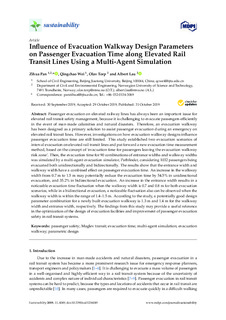| dc.contributor.author | Zihua, Pan | |
| dc.contributor.author | Wei, Qingchau | |
| dc.contributor.author | Lau, Albert | |
| dc.contributor.author | Torp, Olav | |
| dc.date.accessioned | 2019-11-04T08:15:05Z | |
| dc.date.available | 2019-11-04T08:15:05Z | |
| dc.date.created | 2019-10-31T18:45:38Z | |
| dc.date.issued | 2019 | |
| dc.identifier.citation | Sustainability. 2019, 11 (21), 1-17. | nb_NO |
| dc.identifier.issn | 2071-1050 | |
| dc.identifier.uri | http://hdl.handle.net/11250/2626256 | |
| dc.description.abstract | Passenger evacuation on elevated railway lines has always been an important issue for elevated rail transit safety management, because it is challenging to evacuate passengers efficiently in the event of man-made calamities and natural disasters. Therefore, an evacuation walkway has been designed as a primary solution to assist passenger evacuation during an emergency on elevated rail transit lines. However, investigations on how evacuation walkway designs influence passenger evacuation time are still limited. This study established two evacuation scenarios of interval evacuation on elevated rail transit lines and put forward a new evacuation time measurement method, based on the concept of evacuation time for passengers leaving the evacuation walkway risk zone. Then, the evacuation time for 90 combinations of entrance widths and walkway widths was simulated by a multi-agent evacuation simulator, Pathfinder, considering 1032 passengers being evacuated both unidirectionally and bidirectionally. The results show that the entrance width and walkway width have a combined effect on passenger evacuation time. An increase in the walkway width from 0.7 m to 1.5 m may potentially reduce the evacuation time by 54.5% in unidirectional evacuation, and 35.2% in bidirectional evacuation. An increase in the entrance width results in a noticeable evacuation time fluctuation when the walkway width is 0.7 and 0.8 m for both evacuation scenarios, while in a bidirectional evacuation, a noticeable fluctuation also can be observed when the walkway width is within the range of 1.4–1.5 m. According to the study, a potentially good design parameter combination for a newly built evacuation walkway is 1.3 m and 1.4 m for the walkway width and entrance width, respectively. The findings from this study may provide a useful reference in the optimization of the design of evacuation facilities and improvement of passenger evacuation safety in rail transit systems. | nb_NO |
| dc.description.abstract | Influence of Evacuation Walkway Design Parameters on Passenger Evacuation Time along Elevated Rail Transit Lines Using a Multi-Agent Simulation | nb_NO |
| dc.language.iso | eng | nb_NO |
| dc.publisher | MDPI | nb_NO |
| dc.rights | Navngivelse 4.0 Internasjonal | * |
| dc.rights.uri | http://creativecommons.org/licenses/by/4.0/deed.no | * |
| dc.title | Influence of Evacuation Walkway Design Parameters on Passenger Evacuation Time along Elevated Rail Transit Lines Using a Multi-Agent Simulation | nb_NO |
| dc.type | Journal article | nb_NO |
| dc.type | Peer reviewed | nb_NO |
| dc.description.version | publishedVersion | nb_NO |
| dc.source.pagenumber | 1-17 | nb_NO |
| dc.source.volume | 11 | nb_NO |
| dc.source.journal | Sustainability | nb_NO |
| dc.source.issue | 21 | nb_NO |
| dc.identifier.doi | 10.3390/su11205699 | |
| dc.identifier.cristin | 1743007 | |
| dc.description.localcode | © 2019 by the authors. Licensee MDPI, Basel, Switzerland. This article is an open access article distributed under the terms and conditions of the Creative Commons Attribution (CC BY) license (http://creativecommons.org/licenses/by/4.0/). | nb_NO |
| cristin.unitcode | 194,64,91,0 | |
| cristin.unitname | Institutt for bygg- og miljøteknikk | |
| cristin.ispublished | true | |
| cristin.fulltext | original | |
| cristin.qualitycode | 1 | |

